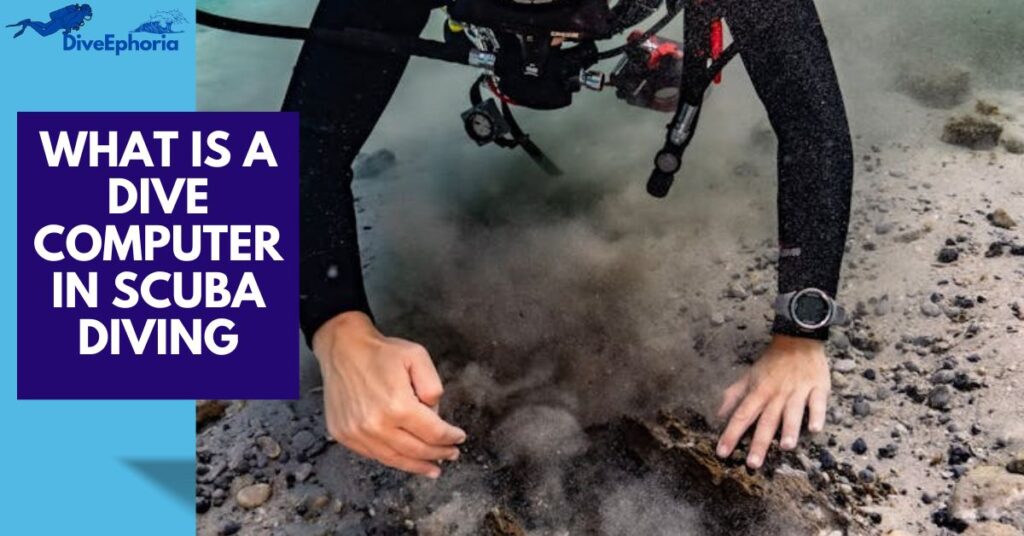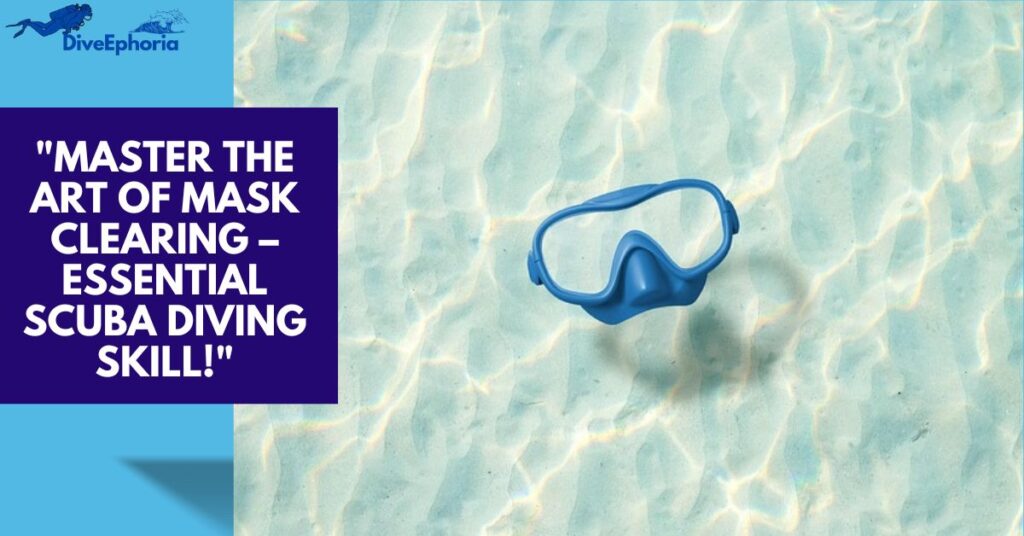
Introduction
Few things can disrupt an otherwise perfect dive quite like a foggy or water-filled mask. As a scuba diver, one of the most essential skills you’ll need to master is clearing your mask underwater. Whether you’re a novice diver or a seasoned pro, learning how to properly clear a mask is crucial for a smooth, safe, and enjoyable underwater experience. A mask that fills with water can cause panic and distract you from the beauty and tranquility of your dive. But with the right technique and practice, you can quickly and efficiently clear your mask, allowing you to focus on the dive rather than the discomfort of fogged or flooded lenses.
Mastering the skill of clearing your mask not only helps improve your visibility and comfort but also enhances your overall safety. It’s an important part of your basic scuba diving skills, ensuring that you remain calm and confident even when faced with unexpected mask flooding. In this guide, we’ll walk you through everything you need to know about mask clearing in scuba diving, including step-by-step techniques, expert tips, and common mistakes to avoid.
why Mask Clearing is Crucial for Scuba Divers
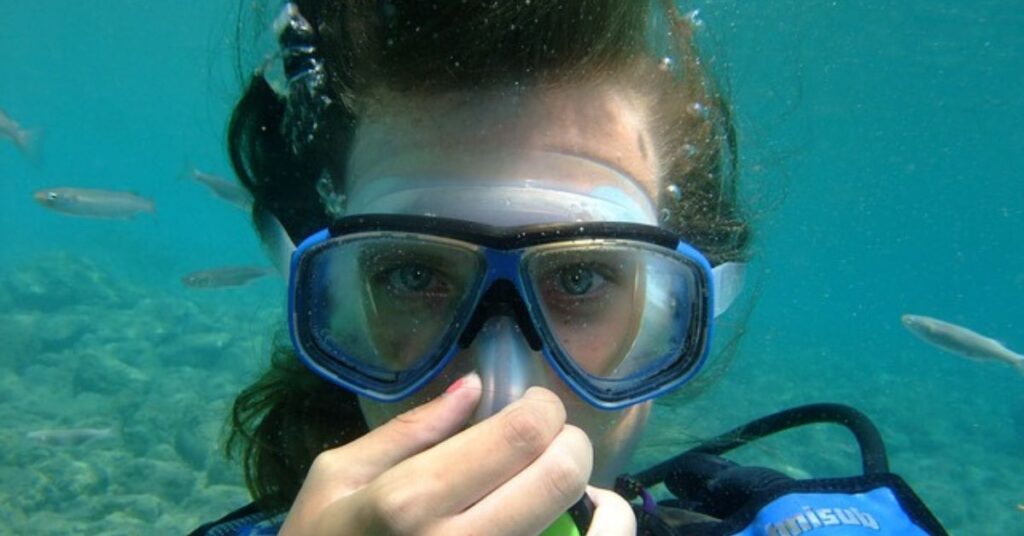
Mask clearing is an indispensable skill for all scuba divers, regardless of their experience level. It’s not uncommon for water to enter a diver’s mask during a dive. Whether it’s from a loose seal, facial movements, or a shift in water pressure, having the ability to clear your mask quickly and effectively can make the difference between a stressful dive and a comfortable, enjoyable one.
One of the primary reasons mask clearing is so crucial for scuba divers is safety. When water floods your mask, it can impair your vision, leading to disorientation and panic. This can be especially dangerous in deep dives or in environments with low visibility. Being able to clear your mask promptly ensures that you can maintain clear sightlines of your surroundings, which is essential for navigation and awareness of your dive team.
In addition to safety, mask clearing is also a matter of comfort. A mask filled with water can create a feeling of unease, causing you to focus more on discomfort rather than on the dive itself. Mastering the art of clearing your mask ensures that your focus remains on enjoying the underwater world, without distractions or unnecessary stress.
Another important factor is that water entering the mask is a natural part of diving, especially if you’re diving in challenging environments like caves, wrecks, or areas with strong currents. Even if your mask fits perfectly, it’s possible for small amounts of water to seep in. In these situations, knowing how to clear your mask is essential to keep the dive going smoothly and safely.
Furthermore, a properly cleared mask also contributes to better communication with your dive buddy and the rest of the dive team. For instance, when you’re not distracted by mask-related issues, you can more easily communicate through hand signals, enhancing teamwork and ensuring everyone’s safety.
By learning how to clear a mask effectively, you are not only addressing an immediate problem but also building confidence in your overall scuba diving skills. It’s a fundamental technique that all divers should be comfortable with, and practicing it regularly in different conditions will ensure that you are prepared for any situation that arises underwater.
Step-by-Step Guide to Clearing Your Mask While Scuba Diving
Knowing how to clear a mask while scuba diving is an essential skill that every diver must master. Whether you’re dealing with a flooded mask or foggy lenses, it’s important to stay calm and use the proper technique to ensure a smooth dive. Below is a comprehensive step-by-step guide to help you clear your mask underwater with confidence and ease.
1. Stay Calm and Maintain Proper Breathing
The first step to clearing your mask effectively is to stay calm. Panicking can make the situation worse, leading to faster breathing or even loss of control over the process.
- Focus on your breathing: Make sure you continue breathing steadily through your regulator. This helps you remain calm and focused while you work on clearing the mask.
- Control your emotions: Take a deep breath, relax, and remind yourself that mask clearing is a basic and manageable skill that every diver practices.
- Use slow, deliberate exhalations: Exhaling steadily through your nose (not your mouth) is key to expelling the water from your mask.
2. Use the Standard Mask Clearing Method
This is the most commonly used method for clearing a mask when it’s flooded with water. It works for most situations and is ideal for beginners or divers who are new to mask clearing techniques.
- Tilt your head upward: Keep your head in a slight upward position. This helps create space for the water to flow out and ensures the proper angle for clearing.
- Press the top of the mask against your forehead: Use your hands to gently press the top of the mask to your forehead, creating a seal. This ensures that no more water will enter the mask while you clear it.
- Exhale forcefully through your nose: With the mask pressed against your forehead, exhale sharply through your nose. This will push the water out of the bottom of the mask.
- Repeat if necessary: If any water remains, tilt your head again and repeat the process until the mask is completely clear. It’s important to stay calm and not rush the process.
This method works well in most situations and is effective in removing small to moderate amounts of water from the mask.
3. The Partial Mask Flooding Technique
For more advanced divers or those who want to practice mask clearing in real-world diving conditions, partial mask flooding is an excellent technique.
- Flood your mask slightly: While maintaining a good seal, allow a small amount of water to enter the mask. This can be done by gently tilting your head downward or adjusting your mask slightly.
- Use the exhale technique: Once the water enters, exhale through your nose to force the water out. You may need to repeat this a few times to fully clear the mask.
- Practice regularly: This technique helps build your confidence in mask clearing and is useful for familiarizing yourself with how your mask behaves under different conditions.
Partial flooding is a great way to get comfortable with clearing your mask during a dive when the water level is low or when a small amount of water has entered.
4. The Full Mask Removal and Replacement Method
This technique is more advanced and should be practiced in shallow, controlled environments. It’s helpful for divers who may experience more significant mask issues, such as a mask being knocked off or significant flooding.
- Exhale continuously: Begin by exhaling steadily through your nose. This creates a constant flow of air that prevents the mask from flooding as you remove it.
- Remove your mask gently: While exhaling, slowly pull the mask off your face. Be mindful of your regulator and make sure your mouthpiece stays in place.
- Replace your mask quickly: Once the mask is off, reposition it on your face and seal it securely. As soon as the mask is back in place, exhale again through your nose to clear any water that might have entered.
- Practice in shallow water: This technique can be more challenging and requires practice in controlled environments before using it in deeper dives. Always ensure you’re comfortable with this technique before attempting it in open water.
Mastering this technique provides you with the ability to handle more extreme mask-related issues underwater, giving you the freedom to dive with greater confidence.
5. Keep Your Mask on Your Face During Emergency Situations
In certain emergency situations, it might be tempting to rip off your mask to see more clearly. However, unless the situation absolutely demands it (such as if you’re trapped or injured), it’s essential to keep your mask on during most emergencies. Mask removal can lead to a loss of visibility and unnecessary panic. Instead, rely on your ability to clear your mask effectively to handle any water that gets inside.
Additional Tips for Mask Clearing:
- Practice in a controlled environment: The more you practice, the more comfortable you will become with clearing your mask. Start in shallow water or during your pool training sessions to build muscle memory and confidence.
- Use your dive buddy for support: If you’re having trouble clearing your mask, don’t hesitate to signal to your dive buddy for assistance. In many cases, they may help you clear your mask or signal for a break to regroup.
- Regularly check your mask fit: A poorly fitting mask is more likely to flood. Make sure your mask fits snugly against your face without being too tight, and adjust it regularly for the best seal.
How to Clean a New Scuba Diving Mask
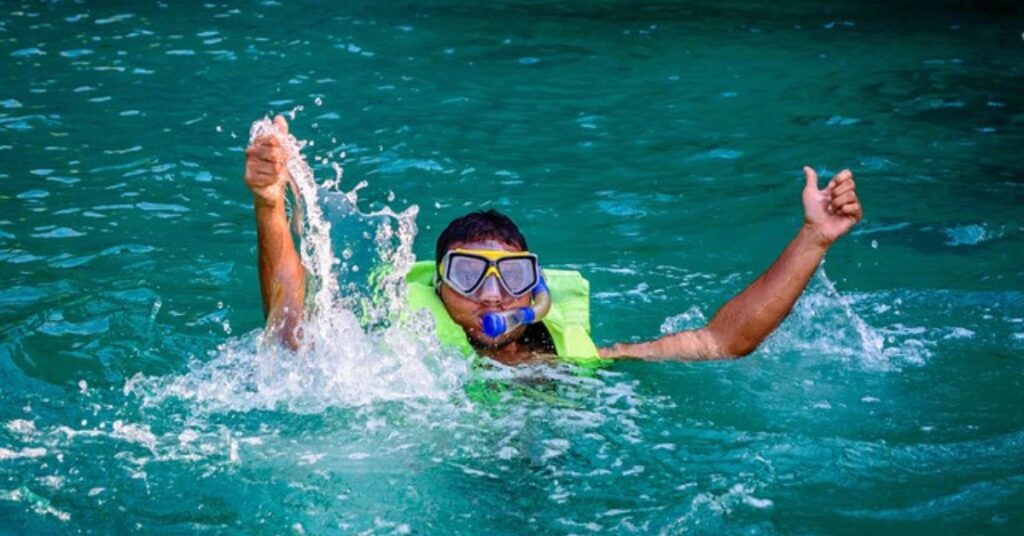
When you purchase a new scuba diving mask, it’s crucial to clean it properly before your first dive. New masks often come with a layer of factory residue on the lenses that can cause fogging, which may significantly impair your visibility underwater. Cleaning your mask before use not only removes this residue but also helps to ensure optimal performance during your dives. Here’s a detailed guide on how to clean a new scuba diving mask, step by step, to avoid any fogging issues and get the best experience.
1. Remove the Factory Residue
New scuba diving masks often have a thin film of silicone or other residue left from the manufacturing process. This film can cause your mask to fog up when you dive, leading to frustrating visibility issues. To prevent this, you need to clean the inside of the lens thoroughly before using your mask.
- Use mild toothpaste or a specialized mask cleaner: One of the most effective ways to clean a new mask is by using a non-abrasive toothpaste (without any whitening agents) or a purpose-made scuba mask cleaner. These products are designed to gently remove the factory coating without damaging the lens.
- Apply a small amount of toothpaste: Put a pea-sized amount of toothpaste on a soft cloth or your fingers. Rub it gently on the inside of the lens in small circular motions to remove the residue.
- Rinse thoroughly: Once the inside of the mask is scrubbed, rinse the mask thoroughly with fresh water to remove all toothpaste or cleaner residue. It’s important to ensure no cleaning product is left behind, as this could affect the mask’s performance.
- Repeat the process: For best results, you may need to repeat the cleaning process a few times. Some divers find it helpful to clean the mask several times before using it to ensure all residue is removed completely.
2. Clean the Mask Strap and Frame
While cleaning the lens is essential, it’s also important to clean the mask’s strap and frame. The silicone straps of your mask can gather dirt, oils from your skin, and other contaminants over time, which can affect the comfort and fit.
- Use mild soap and water: Wash the straps and the frame of your mask with mild soap and lukewarm water to remove any dirt or residue.
- Rinse thoroughly: After cleaning, rinse the mask strap and frame with fresh water to remove any soap residue. This prevents any irritation to your skin when wearing the mask during your dive.
3. Prevent Fogging: Apply an Anti-Fog Solution
Even after cleaning your new mask, fogging can still occur during your first few dives. To ensure your mask stays clear and provides optimal visibility, apply an anti-fog solution before use.
- Choose a high-quality anti-fog solution: There are many anti-fog solutions available on the market specifically designed for scuba diving masks. These products are safe to use on your mask lenses and can significantly reduce the chances of fogging during your dives.
- Apply the solution according to instructions: Most anti-fog solutions are applied directly to the inside of the mask lens. A small drop on each lens should suffice. After applying, gently rub the solution in with your fingers and rinse with water.
- Consider natural anti-fog methods: Alternatively, some divers prefer natural anti-fog methods, such as rubbing a small amount of baby shampoo on the lens, letting it dry, and then rinsing it off. This can provide a temporary anti-fog effect without the need for commercial products.
4. Dry and Store Properly
Once your new mask is cleaned and free of factory residue, you need to store it properly to maintain its longevity and prevent any mold or mildew build-up.
- Dry the mask thoroughly: After each use, rinse the mask with fresh water and allow it to dry completely before storing it. Never leave your mask in direct sunlight for long periods, as this can cause the silicone material to degrade over time.
- Store in a cool, dry place: When not in use, store your mask in a cool, dry place away from heat sources and direct sunlight. A mask case or bag is ideal for keeping your mask protected from scratches and other damage.
- Avoid storing in damp environments: Never leave your mask in a damp bag or a wet environment, as moisture can encourage the growth of mold and mildew, which could damage the silicone and impair the mask’s effectiveness.
5. Regular Maintenance and Cleaning
To keep your mask in top condition throughout its lifespan, regular maintenance is key. It’s important to clean your mask after every dive to remove any saltwater, sand, or debris that might affect its performance.
- Rinse with fresh water: After each dive, rinse your mask thoroughly with fresh water to remove any saltwater, chlorine, or sand. This helps prevent the buildup of salt, which could cause the mask’s materials to break down over time.
- Avoid harsh cleaning methods: While it’s important to clean your mask regularly, avoid using harsh chemicals, abrasives, or rough cloths that could scratch the lens or damage the silicone components.
- Replace straps as needed: Over time, the mask strap may wear out. If you notice signs of wear, replace the strap to ensure a secure fit.
How to Maintain and Clean Your Scuba Diving Mask
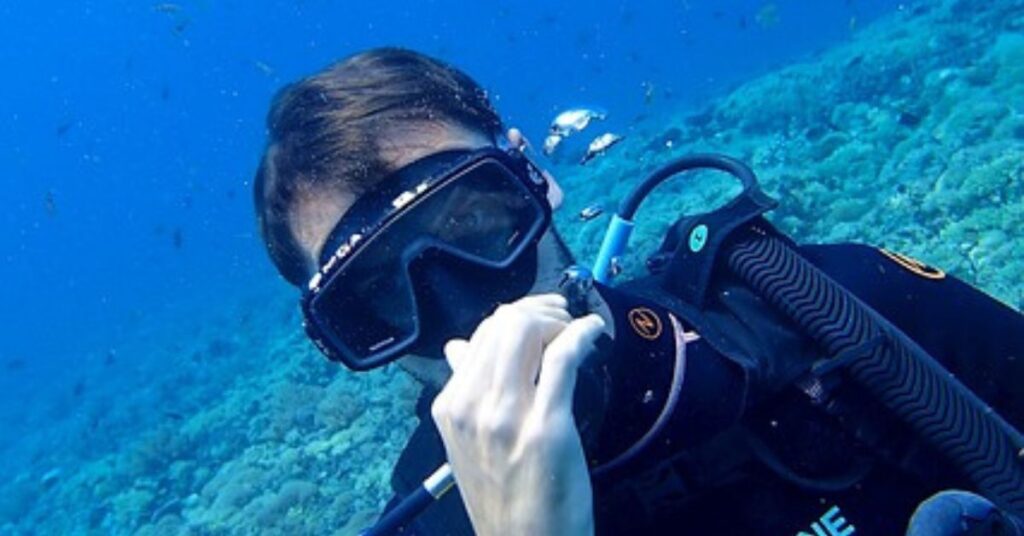
A well-maintained scuba diving mask is essential for both comfort and safety during your dives. Regular cleaning and proper care ensure that your mask lasts longer, performs better, and provides optimal visibility throughout your underwater adventures. Maintaining your mask properly also prevents common issues like fogging, discomfort, and wear and tear. Below is a detailed guide on how to maintain and clean your scuba diving mask to keep it in top condition.
1. Rinse Your Mask After Every Dive
After each dive, it’s important to rinse your mask with fresh water to remove any saltwater, chlorine, or debris that may have accumulated on the lens and silicone components.
- Rinse immediately after your dive: Saltwater and chlorine can cause the silicone parts of your mask to degrade over time, so it’s important to rinse your mask as soon as possible after every dive.
- Use fresh water: Always rinse your mask with clean, fresh water. Avoid using soap or cleaning products at this stage, as this may leave residues that affect your mask’s performance.
- Give extra attention to the skirt and straps: The silicone skirt of your mask can trap saltwater and debris, so make sure you rinse these areas thoroughly. Likewise, don’t forget the straps, as sand and salt can cause them to deteriorate if left unchecked.
2. Clean the Inside of the Mask Lens
Cleaning the lens is one of the most important maintenance tasks for your mask. Over time, oils from your skin and exposure to the elements can cause fogging and cloudiness on the lens. Regular cleaning helps maintain optimal clarity.
- Use a specialized mask cleaner: To keep your mask lens clean and fog-free, use a mask cleaner that is designed for scuba diving equipment. These cleaners are gentle and effective at removing oils, dirt, and residue that could cloud your view.
- Avoid harsh cleaning agents: Do not use window cleaners, bleach, or other harsh chemicals, as these can damage the lens and the silicone components. Stick to cleaners that are specifically designed for diving masks to ensure longevity.
- Use a soft cloth or microfiber towel: When wiping the inside of the lens, use a soft cloth or a microfiber towel to avoid scratching the surface. Never use paper towels or rough fabrics, as these can leave micro-scratches that reduce visibility.
3. Prevent and Clear Mask Fogging
Mask fogging is a common issue among divers, but it can be prevented with a few simple techniques. Understanding how to keep your mask fog-free can make a significant difference in the quality of your dive.
- Use anti-fog solutions: Before each dive, apply an anti-fog solution to the inside of your mask. These products are specifically designed to keep your lenses clear throughout the dive. Apply a few drops of the solution to the inside of the lens, rub it in gently, and then rinse with water.
- Consider natural anti-fog methods: Some divers prefer using natural remedies, such as rubbing a small amount of baby shampoo on the inside of the lens. This can help prevent fogging without the need for chemical products. Just remember to rinse thoroughly after applying.
- Store your mask properly: Avoid storing your mask in a warm, humid environment or in direct sunlight, as this can cause fogging. Keep your mask in a dry, cool place to ensure it remains clear and ready for use.
4. Store Your Mask Properly
Proper storage is crucial for the longevity of your mask. Storing your mask incorrectly can lead to scratches, deformities, and degradation of the silicone skirt and straps.
- Use a protective case or bag: After every dive, store your mask in a protective case or bag. This keeps the mask safe from physical damage and dust buildup. A hard case is ideal for preventing accidental squashing or scratching.
- Avoid storing in direct sunlight: Never leave your mask in direct sunlight for prolonged periods. Ultraviolet rays can weaken the silicone and cause it to lose its flexibility over time. Always store your mask in a shaded area when not in use.
- Keep it away from extreme temperatures: Avoid storing your mask in hot environments, such as a car on a sunny day, as this can cause the silicone to harden or warp. Extreme cold can also make the materials brittle. A cool, dry place is always best.
5. Check the Mask’s Fit Regularly
A properly fitting mask ensures a good seal and comfortable wear throughout your dive. An ill-fitting mask can cause leaks, discomfort, and even affect your ability to clear it effectively. Regularly check the fit of your mask, especially if it’s been a while since your last dive.
- Ensure a secure seal: The mask should fit snugly on your face without being too tight. Check that the skirt creates a good seal around your face without any gaps or pressure points. If you experience leaks during your dives, it may be time to adjust or replace the mask.
- Adjust the straps properly: The straps should be adjusted so that the mask fits securely but comfortably. The strap should be tight enough to keep the mask in place but not so tight that it causes discomfort or pressure on your face.
Conclusion
Mastering how to clear and maintain your scuba diving mask is an essential skill that directly contributes to the overall quality and safety of your underwater experience. Whether you’re dealing with fogging, water leaks, or simply looking to extend the lifespan of your gear, proper cleaning, maintenance, and technique are key.
By following the step-by-step guides outlined in this article, you’ll not only ensure a clear mask that offers optimal visibility but also protect your investment by maintaining its functionality and comfort. Regularly rinsing your mask, using the right anti-fog solutions, storing it correctly, and performing periodic deep cleanings will help prevent common issues like fogging and wear and tear, allowing you to dive with confidence and clarity.
Remember, the key to a successful dive is a clear mask and the knowledge to handle any issues that arise. With consistent care and practice, you’ll be prepared to handle any mask-related challenges while focusing on enjoying the underwater world. Whether you’re a seasoned diver or just starting out, proper mask care is vital for every dive.
FAQs
How often should I practice mask clearing?
Practicing before every dive helps build confidence and ensures you can handle unexpected water leaks.
What should I do if my mask keeps flooding?
Check for proper fit and adjust the strap. Ensure there’s no hair or hood interfering with the seal.
Can I use anti-fog sprays?
Yes, commercial anti-fog solutions help prevent fogging. Ensure they are safe for your mask lens.
What if I wear contact lenses while diving?
Avoid fully flooding your mask and consider using a prescription dive mask.


